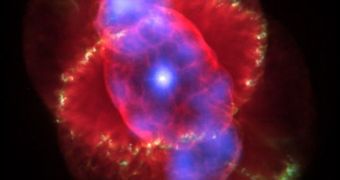According to a consensus growing in the international scientific community, it would appear that planetary nebulae may in fact be shaped up by binary star systems accompanying them. However, proving this is a very complex task.
Astronomers became interested in researching the shapes of these nebulae when they noticed the huge variety that existed here. Some of these structures are wonderfully symmetrical and brightly-colored, whereas others look as if they were assembled at random.
What experts wanted to find was the source for this diversity. Some of the influencing factors experts considered included the presence of strong magnetic fields and very high rotation rates, but none of these scenarios were able to fully explain the variety of shapes.
Now, investigators are beginning to agree that the most irregular planetary nebulae are in fact shaped by the presence of binary star system companions, which influence the vast clouds of gas in the nebula.
However, determining whether this is actually the case or not is very difficult, since experts need a statistically significant sample of planetary nebulae to conduct their research. Discovering binary-core nebulae is very rare.
While analyzing the Milky Way, researchers identified no less than 3,000 planetary nebulae, of which around 40 were demonstrated to have binary cores. Still, it could be that the actual number is a lot higher, since vast distances make it difficult for astronomers to conduct accurate studies.
In the near future, the use of wide field survey missions may increase. This is one of the best approaches towards finding the binary-core nebulae that researchers are looking for. Once more such structures are found, experts will be able to tease out the patterns of their formation.
Theoretically speaking, closely-knit binary systems should have the most drastic influence on the nebula they inhabit. As such, astronomers are focusing their attention on discovering this specific lass of objects, although other types would do just as well.
The NASA Hubble Space Telescope is one of the most widely used assets for detecting these cosmic structures. It sensitive detectors have thus far revealed the existence of numerous binary-core nebulae, Universe Today reports.

 14 DAY TRIAL //
14 DAY TRIAL //